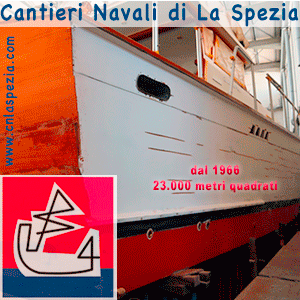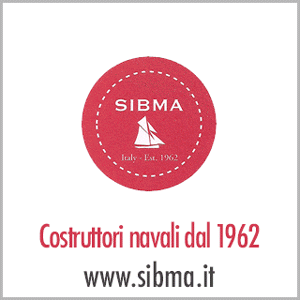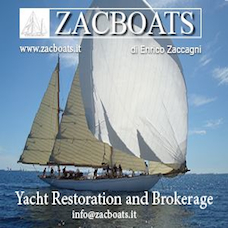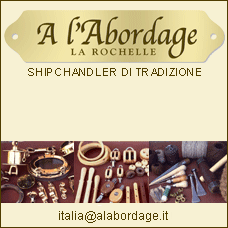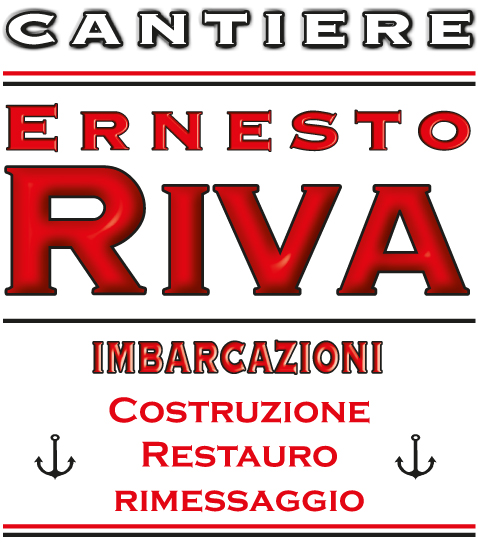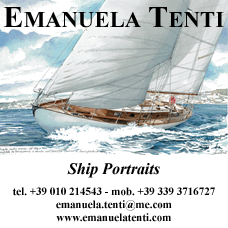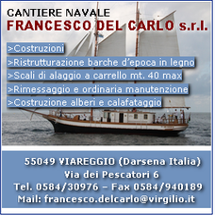
ITALIAN / ENGLISH TEXT
Di Paolo Maccione – Marzo 2019
Fotografie di Paolo Maccione
1929-2019, IL DRAGONE COMPIE 90 ANNI 
Il danese Børge Børresen, leggenda del Dragone sia sui campi di regata che in qualità di costruttore di queste barche, soleva ricordare che “il problema con le regate tra scafi One-Design è che il più bravo di solito vince”. Non sfugge a questa logica il Dragone, l’imbarcazione monotipo a chiglia più diffusa al mondo. Lunga 8,90 metri, larga 1,95 metri, armata a sloop Marconi, è nata nel 1929 dalla matita del prolifico yacht designer norvegese Johan Anker (1871-1940), già autore di scafi metrici della Stazza Internazionale. All’epoca Anker concepì una barca piccola e dai costi contenuti, in grado di aggiudicarsi la regata organizzata dal Royal Gothenburg Yacht Club. Grazie alla piccola cabina e a due rudimentali posti letto poteva anche compiere brevi crociere nei fiordi. Tra il 1948 e il 1972 il Dragone divenne classe olimpica. Proprio da quando fu esclusa dai Giochi, grazie al lavoro dell’IDA (International Dragon Association, www.intdragon.net), che ne ha gestito bene la stazza e limitato la corsa all’armamento, ha aumentato la sua diffusione. Oggi il Dragone è rappresentato in 31 nazioni di 5 continenti. In Italia e in Mediterraneo il cantiere di riferimento per professionalità, restauro e manutenzione è diventato la Sibma Navale di Imperia di Mario e Andrea Quaranta (www.sibma.it), padre e figlio, anche attivi regatanti a bordo del loro Little Diva del 2010, campione italiano in carica. Si calcola che siano ben 1360 gli scafi registrati nel 2019, escluso un pari numero di barche impiegate nel diporto.
I NUMERI DEL DRAGONE
Tecnica, fisicità, attenzione al dettaglio, meticolosità. È quanto necessario per condurre un Dragone. Bisogna essere innanzitutto bravi velisti, in grado di gestire contemporaneamente una dozzina di manovre e regolazioni, continuamente modificabili in base alle mutate condizioni di vento e di onda. L’equipaggio può essere composto da 3 o 4 persone. L’importante è, come da regolamento, che non venga superato il peso complessivo di 285 chilogrammi. Non si regata con un vento inferiore a 3 m/s, circa 6 nodi di intensità, ma non sussiste un limite massimo. Ad esempio nel 2018, in occasione del Campionato Italiano Open di Sanremo, si è regatato con oltre 35 nodi di vento, spesso planando sulle onde a 16 nodi di velocità. Pur con tutta la randa issata e lo spinnaker, la tenuta di mare del Dragone si è dimostrata superlativa. I Dragone costruiti dopo il 2009 possono anche permettersi di scuffiare senza temere di affondare, grazie a una riserva di galleggiamento pari a 2100 litri che ne garantisce l’insommergibilità. La barca è facilmente carrellabile e la sua larghezza, inferiore a 2 metri, rientra nel limite massimo dei 2,50 metri per poterla movimentare su strada (il peso è di 1.700 chilogrammi e il pescaggio di 1,20 metri).
IL PROFILO DELL’ARMATORE 
L’armatore del Dragone è di solito di età compresa tra 40 e 60 anni, spesso ex campione proveniente da competizioni e vittorie internazionali conseguite a bordo di derive come la Star, il Soling, il Finn o il Flying Dutchman. Tra questi anche il 62enne inglese Lawrie Smith, vincitore di un oro olimpico nella classe Soling nel 1992, già skipper in occasione di tre giri del mondo in regata. Poche le donne presenti, perlopiù di nazionalità tedesca, inglese o olandese. I dragonisti europei provengono principalmente da nazioni come la Francia, la Germania, il Portogallo, la Spagna, l’Italia e da Paesi nordici come la Svezia e la Norvegia. Al campionato del mondo, che si svolge negli anni dispari, partecipano sempre circa 80 imbarcazioni. In quelli pari si tiene il campionato europeo, con un numero massimo imposto di 60 barche. Alla Gold Cup, disputata annualmente solo presso alcune selezionate nazioni europee, si iscrivono anche 100 Dragoni e vengono corse 6 prove (senza scarto). Una flotta di oltre 60 scafi partecipa regolarmente ogni settembre alle Règates Royales di Cannes, in Costa Azzurra.
I CANTIERI COSTRUTTORI DEL DRAGONE 
Ad oggi sono tre i principali costruttori al mondo di Dragoni: il danese Borresen (www.borresen.com), che ne ha varati più di 1500 in oltre 60 anni, l'inglese Petticrows (www.petticrows.co.uk), oltre 700 Dragoni costruiti, e il tedesco Glas (www.bootswerft-glas.de) che nel 2019 festeggia 40 anni da quando ha cominciato a produrre queste barche. Da poco più di un decennio si è aggiunto anche il cantiere ucraino Lagoon Royal (www.lagoonroyal.com), autore di new classic in legno a vela e a motore. Il loro Dragone, realizzato interamente in legno e già venduto in diversi esemplari, ha superato con successo i controlli effettuati all’epoca da Gunter Ahlers, stazzatore dell'International Dragons Federation. Oggi il Dragone continua ad essere costruito al ritmo di 40-50 unità all'anno.
DRAGONI E DRAGONISTI ITALIANI 
L’associazione italiana classe Dragone (www.assodragone.it) è stata costituita nel 1989 dal bolognese Piero Guidi, scomparso nel 2008. La figlia Susanna ha poi seguito le orme paterne regatando a bordo di Buriana del 1963. A gestire l’associazione per oltre un ventennio è stato Antonio ‘Tonino’ Viretti, presidente e factotum ancora in carica. Genovese, classe 1936, ex dirigente del settore farmaceutico e velista per oltre mezzo secolo ha sempre regatato sul suo Dragone Fanfouette. I primi Dragoni italiani sono stati Ausonia (ITA-1), un cantiere Beltrami del 1948 donato a metà degli anni Novanta al presidente del Reale Yacht Club Canottieri Savoia di Napoli, e Blue Mallard (ITA-2), costruito nel 1949 dal cantiere norvegese Brødrene Rolands sul quale ha regatato in passato anche l’ex ammiraglio della Marina Militare Cristiano Bettini. Tra gli altri Dragoni visti sui campi di regata Fafnir III, Japetus, Alì Babà II del 1964, Tramontana, Cloud del pluricampione veneziano Giuseppe Duca, Celina III, Acanto del 1966 e Nathaly del 1961. Galatea II, varato dal cantiere Baglietto di Varazze nel 1951, ha partecipato alle Olimpiadi finlandesi di Helsinki del 1952, dove si è piazzata nona su diciassette partecipanti. Oggi regata grazie ai fratelli milanesi La Scala e sullo scafo sono ben visibili i cinque cerchi olimpici. A Taifun del 1936, costruito in Svezia, e Stella III il primato di essere i più vecchi Dragoni in legno naviganti in Mediterraneo, nonché tra i più antichi al mondo. In epoca recente Taifun ha fatto base presso lo Yacht Club Italiano di Genova.
I DRAGONI ALLA SIBMA NAVALE DI IMPERIA
Sono sempre una dozzina i Dragoni rimessati o sottoposti a interventi di ordinaria o straordinaria manutenzione all’interno della Sibma Navale di Dolcedo, nell’entroterra ligure alle spalle di Imperia. Il cantiere è diventato un punto di riferimento per i dragonisti europei. Su richiesta può trasferire i Dragoni dei clienti sui vari campi di regata, armandoli “ready to race”. Dopo le competizioni li disarma e li riporta in cantiere. Tra quelli sottoposti a restauro Venture, costruito nel 1960 in fasciame di mogano su ossatura in frassino dal cantiere danese Pedersen & Thuesen (operativo tra il 1949 e il 1983). La barca, entrata alla Sibma a novembre 2018, ha conseguito numerosi successi in Inghilterra negli anni Sessanta, poi è finita in Olanda. L’attuale armatore italiano tornerà ad utilizzarla dalla primavera del 2020, dopo un restauro integrale “top race condition”. Raubritter è un altro Pedersen & Thuesen del 1964, costruito anch’esso in fasciame di mogano e frassino, oggi di proprietà di un russo. Entrato nell’ottobre del 2018 uscirà a maggio 2019. A questi si aggiungono Zenith, un Borresen del 2002 in vetroresina con sovrastrutture in legno, Michina, un Dragone cruiser con cabina e cuccette varato alla fine anni Cinquanta dal cantiere Hannibal di Monfalcone. In rimessaggio Blue Haze, un Pedersen & Thuesen del 1959, lo storico Venilia, un Borresen del 1957 vincitore della medaglia di bronzo alle Olimpiadi di Napoli del 1960, di proprietà di Mario Quaranta, Javelin, un Pedersen del 1962, Josephine, un Pedersen del 1959 già vincitore di una Gold Cup e Jeanie, un Petticrows del 2018. Si calcola che in Italia siano stati 70 i numeri velici rilasciati dalla classe Dragone a partire dal 1929.
DRAGONE, IL CALENDARIO DELLE REGATE 2019
22/24-02-2019 Alassio Dragon Trophy (1^ prova Campionato Italiano Open)
14/17-03-2019 Sanremo Italian Dragon Cup (2^ prova Campionato Italiano Open)
30/04/2019 – 04/05/2019 Torbole (TN) - International German Championship
11/12-05-2019 Imperia Porto Maurizio - West Liguria Sail & Taste Series - Rossese Regatta
28/30-06-2019 Imperia Porto Maurizio - Ernesto Quaranta Trophy (Classic Dragons Open)
13/14-07-2019 Imperia Porto Maurizio - West Liguria Sail & Taste Series – Pigato Regatta
02/04-10-2019 Torbole (TN) - Hans-Detmar Wagner Cup
05/13-10-2019 Sanremo - 90th Anniversary Regatta
23/24-11-2019 Imperia Porto Maurizio - Partnership Trophy
INFORMAZIONI
www.sibma.it
www.assodragone.it
www.intdragon.net
GALLERY
ENGLISH TEXT
1929 - 2019, the Dragon is 90 years old
In 2019 the timeless Dragon, the most widespread one-design keel boat in the world, designed in 1929 by Johan Anker, is 90 years old. This 8,90 meter long yacht, easily towable, was initially built in wood and for a quarter of a century she was an Olympic Class. Starting from 1973 she began to be realized also in G.R.P., up to exceed the more than 6500 specimens launched in the world. This year also the Italian Class Association, founded in 1989, celebrates its thirtieth anniversary.
By Paolo Maccione - March 2019
Photographs by Paolo Maccione
1929 - 2019, THE DRAGON IS 90 YEARS OLD
The Danish Børge Børresen, legend of the Dragon both on the regatta fields and as builder of these boats, used to remember that "the problem with the regatta among One-Design boats is that the best one usually wins". The Dragon does not escape this logic, the most widespread one-design keel boat in the world. 8.90 meter long, 1.95 meter wide, this sloop Marconi was conceived in 1929 by the prolific Norwegian yacht designer Johan Anker (1871-1940), already author of international metric class boats. At the time Anker conceived a small boat with low costs, able to win the regatta organized by the Royal Gothenburg Yacht Club. Thanks to the small cabin and two rudimentary berths she could also take short cruises in the fjords. In 1948 the Dragon became an Olympic Class. Since 1972, when she was excluded from the Games, she has increased her popularity, thanks to the IDA (International Dragon Association, www.intdragon.net), which well managed her measurement control and limited the introduction of news. Today the Dragon is represented in 31 nations of 5 continents. In Italy and in the Mediterranean the reference yard for professionalism, restoration and maintenance has become the Sibma Navale of Mario and Andrea Quaranta (www.sibma.it), father and son, also active racers on board their dragon "Little Diva", Italian champion in charge. It is estimated that in 2019 there are 1360 dragons registered for racing, excluding an equal number of dragons used only for pleasure.
THE NUMBERS OF THE DRAGON
Technique, physicality, attention to detail, meticulousness. It is what is necessary to conduct a Dragon. First of all one need to be good sailor, able to manage at the same time a dozen maneuvers and adjustments, continuously modifiable according to the changed wind and wave conditions. The crew can be composed of 3 or 4 people. The important thing is, as per regulation, that the total weight of 285 kilograms is not exceeded. Usually she does not race with a wind less than 3 m/s, about 6 knots, but there is no maximum limit. For example, in 2018, during the Italian Open Championship in Sanremo, the fleet raced with over 35 knots of wind, often gliding on the waves at 16 knots of speed. Even with all the mainsail hoisted and spinnaker, the Dragon proved to be superlative and sure. The Dragons built after 2009 cannot sink, thanks to a floating reserve of 2100 liters that guarantees the buoyancy. The boat is easily towable and its width, less than 2 meters, is within the maximum admitted limit of 2.50 meters (the boat weight is 1,700 kilograms).
THE OWNER PROFILE
The owner of the Dragon is usually a manager or a professional aged between 40 and 60, often a former champion from international competitions and victories achieved on board international class such as the Star, the Soling, the Finn or the Flying Dutchman. These include the 62-year-old English Lawrie Smith, who won in 1992 an Olympic gold medal in the Soling class, who was already skipper in three around the world races. Few women are racing in Dragon, mostly of German, English or Dutch nationality. The European dragonists come mainly from nations such as France, Germany, Portugal, Spain, Italy and from Nordic countries like Sweden and Norway. Around 80 boats participate in the world championship, which takes place over the odd years. In the even ones the European championship is held, with a maximum number of 60 boats. At the Gold Cup, held annually only in selected European countries, 100 Dragons are also registered and 6 races are run (without any discharge of results). A fleet of over 60 boats regularly takes part every September at the Régates Royales in Cannes, on the French Riviera.
DRAGON SHIPYARDS
To date, the world's leading Dragon manufacturers are: the Danish Borresen (www.borresen.com), which has launched more than 1500 in over 60 years, the English Petticrows (www.petticrows.co.uk), 700 Dragons built, and the German Glas (www.bootswerft-glas.de) which celebrates 40 years in 2019 since it began producing these boats. The Ukrainian shipyard Lagoon Royal (www.lagoonroyal.com), author of new classic sailing and motor wooden boats, has been added for just over a decade. Their Dragon, made entirely of wood and already sold in several examples, has successfully passed the checks carried out at the time by Gunter Ahlers, measurer of the International Dragons Association. Today the Dragon continues to be built at the rate of 40-50 units a year.
DRAGONS AND ITALIAN DRAGONISTS
The Italian Dragon Association (www.assodragone.it) was founded in 1989 by the Bolognese Piero Guidi, who died in 2008. His daughter Susanna then followed in his father's footsteps racing aboard Buriana of 1963. To manage the association for over twenty years ago Antonio 'Tonino' Viretti, president and factotum still in charge. Genovese, born in 1936, former manager of the pharmaceutical sector and sailor for more than half a century, has raced on his Dragon Fanfouette since 2004. The first Italian Dragons were Ausonia (ITA-1), built by Beltrami shipyard in 1948 donated in the mid-nineties to the president of the Royal Yacht Club Canottieri Savoia of Naples, and Blue Mallard (ITA-2), built in 1949 by the Norwegian shipyard Brødrene Rolands on which former Admiral of the Italian Navy Cristiano Bettini has raced in the past. Among the other Dragons seen on the regatta fields Fafnir III, Japetus, Alì Babà II of 1964, Tramontana, Cloud of the Venetian champion Giuseppe Duca, Celina III, Acanto of 1966 and Nathaly of 1961. Galatea II, launched in 1951 by the shipyard Baglietto, she participated in the Finnish Helsinki Olympics in 1952, where she was placed ninth on seventeen participants. Today she races thanks to the Milanese brothers La Scala and on the hull the five Olympic circles are clearly visible. In 1936 Taifun, built in Sweden, and Stella III the record of being the oldest wooden sailing Dragon in the Mediterranean, as well as among the oldest in the world. In recent times Taifun made a base at the Yacht Club Italiano in Genoa.
DRAGONS AT SIBMA NAVALE
There are always a dozen Dragons subjected to ordinary or extraordinary maintenance work inside the Sibma Navale shipyard in Dolcedo, in the Ligurian hinterland behind Imperia. The yard has become a reference point for European dragonists. On request the customers' Dragons are transferred on the various race fields, by making them "ready to race". Than, after the races, the boats are brought back to the yard. Among those undergoing restoration Venture, built in 1960 in mahogany plating on the skeleton in ash by the Danish yard Pedersen & Thuesen (operating between 1949 and 1983). The boat entered the Sibma in November 2018, achieved many successes in England in the sixties, then it ended up in Holland. The current Italian owner will return to sail from the spring of 2020, after a complete "top race condition" restoration. Raubritter is another 1964 Pedersen & Thuesen, also built in mahogany and ash, which is now owned by a Russian. Entered in October 2018 will be released in May 2019. To these are added Zenith, a Borresen of 2002 in fiberglass with wooden roof and deck, Michina, a Dragon with cabin and berths launched in the late fifties by the Hannibal shipyard in Monfalcone. In storage Blue Haze, a Pedersen & Thuesen of 1959, the historical Venilia, a 1957 Borresen winner of the bronze medal at the 1960 Olympics in Naples, owned by Mario Quaranta, Javelin, a Pedersen of 1962, Josephine, a Pedersen of 1959 already winner of a Gold Cup and Jeanie, a Petticrows of 2018. It is estimated that in Italy there were 70 sail numbers released by the Dragon class.
DRAGON, THE CALENDAR 2019
22/24-02-2019 Alassio Dragon Trophy (1st round of the Italian Open Championship)
14/17-03-2019 Sanremo Dragon Cup (2nd round of the Italian Open Championship)
30/04/2019 - 04/05/2019 Torbole (TN) - International German Championship
11/12-05-2019 Imperia Porto Maurizio - West Liguria Sail & Taste Series - Rossese Regatta
28/30-06-2019 Imperia Porto Maurizio - Ernesto Quaranta Trophy (Classic Dragons Open)
13/14-07-2019 Imperia Porto Maurizio - West Liguria Sail & Taste Series - Pigato Regatta
02/04-10-2019 Torbole (TN) - Hans-Detmar Wagner Cup
05/13-10-2019 Sanremo - 90th Anniversary Regatta
23/24-11-2019 Imperia Porto Maurizio - Partnership Trophy
INFORMATIONS
www.sibma.it
www.assodragone.it
www.intdragon.net









































